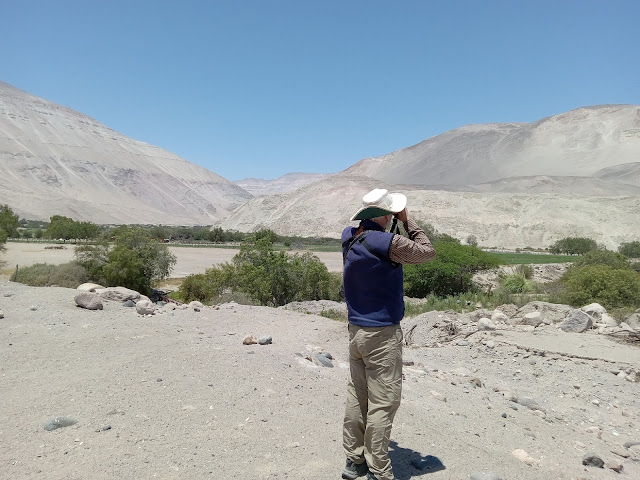Another great day in the Andes Mountains. We got picked by our new driver, Henry, in a big new Mercedes Sprinter, so travelled in style.
It's a Mediterranean climate ( similar to coastal California) andmuch greener than the Atacama desert.
We drove up the Meipo River, hotspot for kayaking. The hills and meadows were full of . . . . California poppies! Yep, invasive weed but a pretty one.
We had just turned off towards the Yeso River when we spotted a mustached turca. The turca unlike the other more furtive tapaculos, doesn't mind perching on top of a shrub, calling loudly.
Moustached turca showing off
Stopping for turcas, fancy van behind
Also seen here:
Chilean mockingbird
At the next stop we saw our first Andean condor (no picture, alas)! The largest raptor in the world!
And on another scale, this little guy:
Our next stop was high above the Yeso River searching for torrent ducks.
Bingo!
This was a very special moment. We got to watch the male, female and their duckling ferry across the rapid one by one and slip into an eddy before disappearing downstream.
Male and female torrent ducks are both pretty flashy
Pretty special viewing for two (former) whitewater kayakers.
The wetland meadows at this elevation are called vegas. They are used for posturing cattle. We stopped at this one too look for birds.
This is seedsnipe. Look at its beautiful scalloped feathers.
Gray-breasted seedsnipe
We saw our first Magellanic tapaculo here.
Ebird describes it as moving through bamboo like a mouse. That accurately describes what we observed here ( Except in rushes).
We also saw a good assortment of the brownish/grayishbirds that kept me pretty confused:
Gray-flanked cinclodes
But also these colourful guys!
There's actually a bunch of these sierra finches to confuse a person too.
At the end of the road is the Yeso reservoir.
On the way back we stopped at the "facilities," where I was dismayed to find the 500 peso ($.50) charge did not include a toilet seat! However, all the toilet paper you needed. Actually, I thought it was a pretty entrepreneurial way to supplement a pretty hardscrabble homestead.
Leo caught me napping on the drive back.
Xx
Selfie with reclining napper
I woke up to
A giant bumblebee on my hand! Initially a little freaked out (allergies), but the bee was pretty chill, and I made Leo take a picture before escorting it out.
Supper was at a Basque/Spanish restaurant near our hotel in Las Condes neighbourhood od Santiago, Pinpilinpausha. Nick and I both had garbanzo stew with shrimp, and we both agreed it was the best tasting chickpeas we'd ever eaten. The serving was enormous so I left half behind but Nick had his for breakfast the next day
Count: 35 species, 21 lifers.

























































